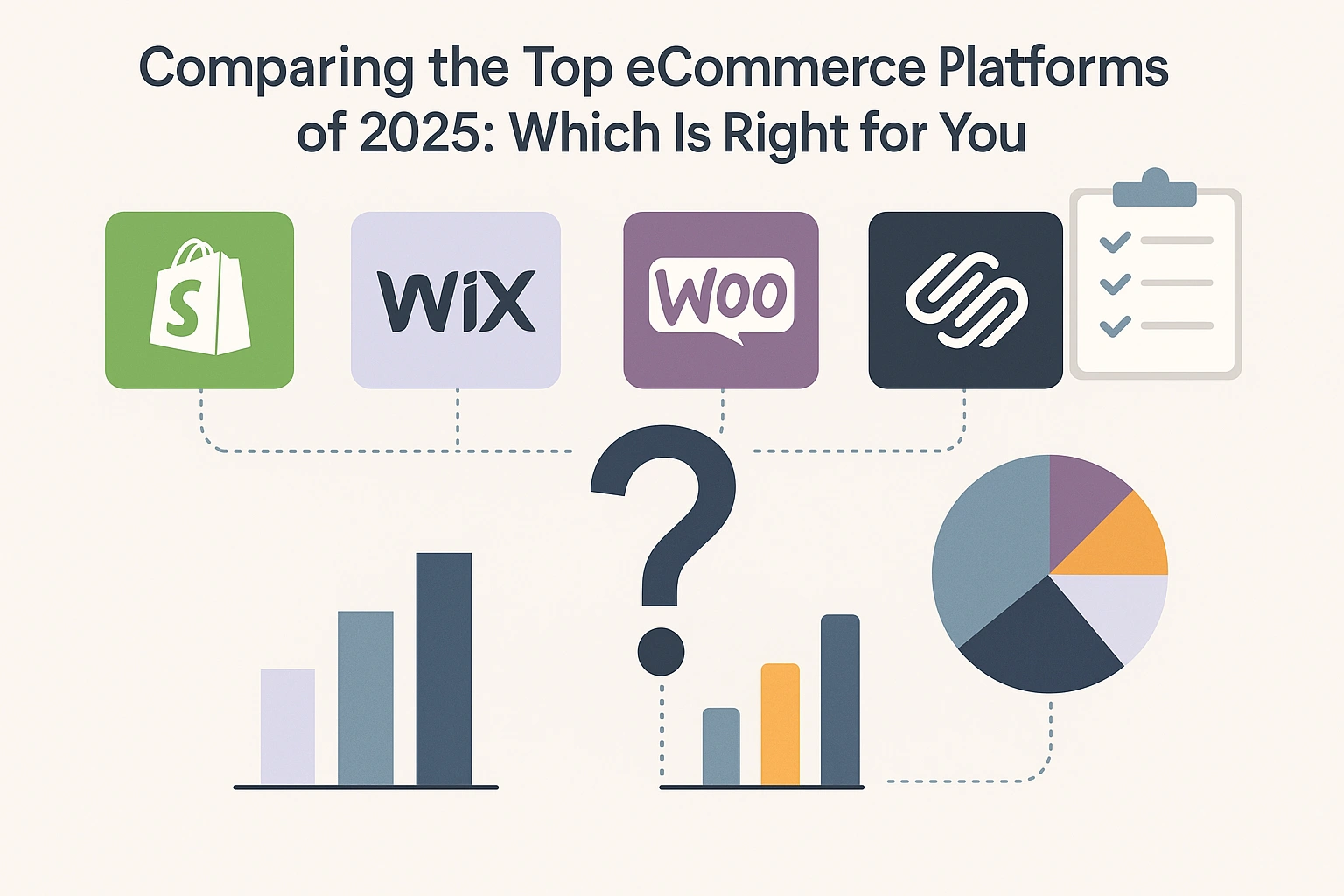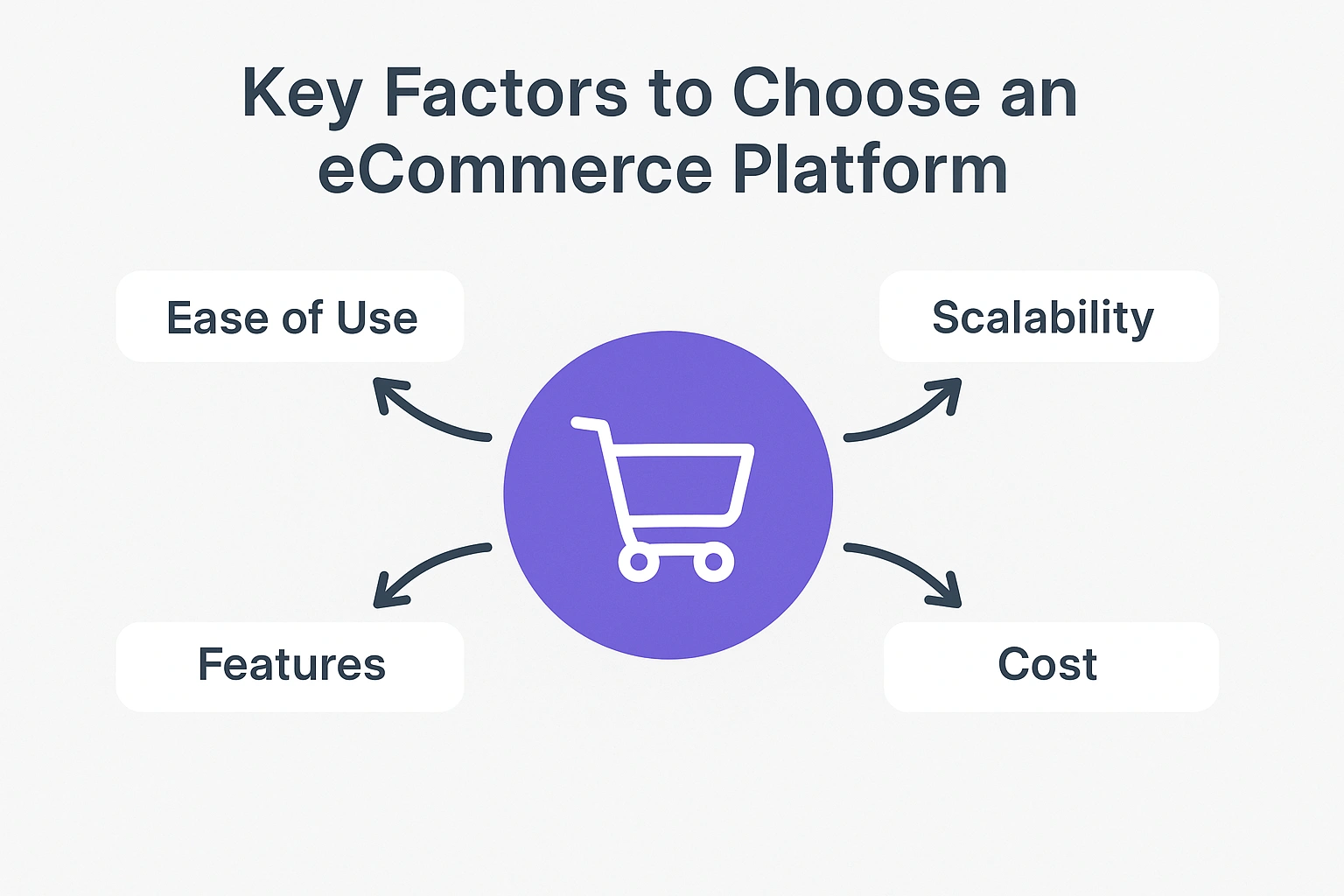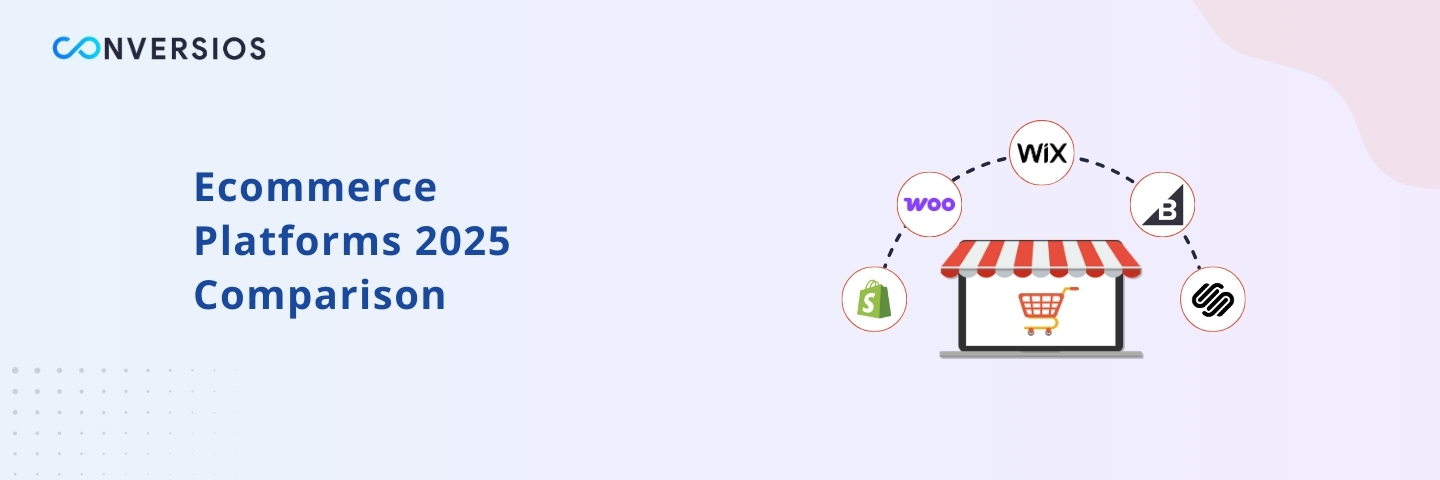Starting an online store in 2025 is both exciting and overwhelming. The tools available today make it possible to set up a shop in hours, but the number of choices can leave you stuck before you even begin.
Do you go with a quick website builder that lets you drag and drop everything into place? Or should you pick a heavyweight platform that is built to handle thousands of products and global sales? The truth is that there is no one-size-fits-all answer.
This guide looks at the top eCommerce platforms in 2025, including Shopify, Wix, WooCommerce, BigCommerce, Squarespace, and a few niche options. We will look at where each platform shines, what its limits are, and which types of businesses will get the most out of it. By the end, you should know which platform fits your business goals, your budget, and the way you like to work.
What Matters When Choosing an eCommerce Platform in 2025
Before you compare platforms side by side, it helps to know what really makes a difference for your business. In 2025, the best eCommerce platform is not only about having nice templates or easy checkout. It is about how well the platform supports your growth, reduces your workload, and fits your budget.
Here are the key factors to look at:
- Ease of setup: Can you launch quickly without coding skills, or do you need developer support?
- Scalability: Will the platform still perform well when you move from ten sales a month to ten thousand?
- Pricing and fees: Subscription costs, payment gateway charges, and hidden add-ons can add up fast.
- AI features: Many platforms now include AI store builders, product recommendations, or automated marketing.
- Design flexibility: Do you get the creative control to match your brand identity, or are you locked into rigid layouts?
- Integrations: From shipping apps to point-of-sale systems, you need smooth connections with the tools you already use.
- Support and security: Look for responsive support, PCI compliance, and reliable uptime.
Keeping these factors in mind will help you filter out platforms that look attractive at first but may not meet your long-term needs.
Best eCommerce Platforms of 2025 Reviewed

Here is a closer look at the leading eCommerce platforms of 2025, their strengths, and where they might fall short.
1. Shopify
Shopify remains the top choice in 2025, powering millions of stores across industries. Our Google Ads campaign setup guide will help you capture traffic effectively from day one.
Why people choose it:
- Quick to set up, even for beginners
- Scales easily from small to enterprise level
- 8,000+ apps for marketing, analytics, and automation
- AI helpers like Shopify Magic and Sidekick
Limitations of Shopify:
Pricing starts at $29 per month. Costs increase as you add apps or advanced features, which may feel heavy for small stores.
Best for: Businesses planning fast growth and needing a reliable all-in-one platform.
2. Wix
Wix has become one of the easiest eCommerce platforms to start with in 2025, especially for beginners and small businesses.
Why people choose it:
- Drag-and-drop builder with flexible templates
- Affordable entry plans starting around $17 to $29 per month
- Built-in SEO and marketing features
- AI Website Builder for fast store creation
Limitations of Wix:
Wix is perfect for smaller shops and creative entrepreneurs, but it can feel limited when managing very large product catalogs or advanced enterprise needs.
Best for: Freelancers, creatives, and small businesses that want a simple and professional online store.
3. WooCommerce (WordPress)
WooCommerce remains the go-to solution for WordPress site owners who want to add eCommerce functionality with full control. Understanding server side tagging explains how to keep your data accurate as your store grows.
Why people choose it:
- Free to install and open-source
- Seamless integration with WordPress websites
- Extensive plugins and extensions available
- Highly customizable for developers and advanced users
Limitations of Woocommerce:
It requires more technical skills than hosted platforms. Ongoing updates, plugin management, and hosting costs can add complexity for beginners.
Best for: WordPress users and businesses that want maximum flexibility and customization.
4. BigCommerce
BigCommerce is designed for scalability, making it a strong option for growing businesses and enterprises. Our Microsoft Advertising guide shows how to expand reach beyond Google campaigns.
Why people choose it:
- Robust built-in SEO tools
- Multi-storefront and B2B selling support
- Enterprise-grade security and PCI compliance
- Supports multiple currencies and languages
Limitations of BigCommerce:
Its plans start at $29 per month, and while feature-rich, it can feel overwhelming or unnecessary for very small stores.
Best for: Mid-sized and large businesses that need advanced features and multi-channel support.
5. Squarespace
Squarespace continues to be a favorite for creative businesses, offering some of the best design templates in 2025. Setting up Facebook Pixel tracking can help improve ad performance for creative brands.
Why people choose it:
- Beautiful, design-forward templates
- All-in-one hosting and website builder
- Plans ranging from $16 to $99 per month
- Integrated analytics and marketing tools
Limitations of Squarespace:
It does not scale as well as Shopify or BigCommerce and is better suited for small to mid-sized businesses.
Best for: Creatives, designers, and entrepreneurs who want stunning visuals with easy store management.
Other Contenders
Several smaller platforms are also part of the eCommerce conversation in 2025.
Why people choose them:
- Square Online: Perfect for syncing physical retail with online sales
- GoDaddy: Fast AI-assisted setup for beginners
- Hostinger: Affordable AI-powered store builder
- Spocket: Great for dropshipping with supplier catalogs
- Big Cartel: Simple platform for artists and makers with limited product lines
- Shift4Shop: Known for advanced SEO tools at affordable pricing
- OpenCart: Open-source flexibility for developers
- Volusion: Long-standing option with inventory and marketing features
Limitations of these platforms:
Each of these alternatives tends to specialize in one niche, which means they may lack the all-in-one flexibility or scalability of larger platforms. Following our fix missing revenue in GA4 guide ensures your analytics stays reliable if you choose one of these tools.
Best for: Sellers with very specific needs like dropshipping, small creative shops, or physical retailers moving online.
How to Choose the Right Platform for Your Business

The best eCommerce platform for you depends on where your business is today and where you want it to go. Here are some common scenarios:
For first-time sellers:
Wix or GoDaddy are ideal. They are easy to set up, affordable, and do not require technical skills.
For businesses planning to scale quickly:
Shopify or BigCommerce work best. Both can handle large catalogs, heavy traffic, and multiple sales channels.
For WordPress site owners:
WooCommerce is the natural choice. It lets you turn your existing site into a fully functional store with complete flexibility.
For creative brands:
Squarespace is the strongest option. Its templates make your products stand out with minimal effort.
For dropshipping stores:
Spocket is designed for this model, with access to global suppliers and simple integrations.
For physical retailers moving online:
Square Online makes it easy to sync in-store inventory with your eCommerce shop.
Final Thoughts
There is no single eCommerce platform that fits every business in 2025. The right choice depends on your current stage, your budget, and how you plan to grow.
- If you are just starting out, platforms like Wix or GoDaddy will help you launch quickly.
- If you are aiming for rapid growth, Shopify or BigCommerce are reliable long-term partners.
- For WordPress users, WooCommerce provides unmatched flexibility.
- Creative brands often lean toward Squarespace for its design power.
- And for niche needs like dropshipping or retail sync, tools like Spocket and Square Online fill the gap.
The best way forward is to test at least two platforms. Most offer free trials, so you can get a feel for the interface, the features, and the overall experience. Choose the one that makes running your store feel easier, not harder.
Next step: Try a free trial today and see which platform fits your business best.
Frequently Asked Questions
Q. Which eCommerce platform is easiest to use?
Wix is the most beginner-friendly. Its drag-and-drop builder and AI Website Builder make it possible to launch a store in just a few hours.
Q. Which platform is best for scaling as I grow?
Shopify is the strongest option for growth. It supports thousands of apps, integrates with major sales channels, and handles large inventories with ease.
Q. What is the most affordable option?
WooCommerce can be the cheapest if you already use WordPress. The plugin itself is free, and costs mostly depend on hosting and extensions.
Q. Which platform is best for dropshipping?
Spocket is built for dropshipping. It connects you with suppliers, integrates easily with Shopify and WooCommerce, and helps you launch quickly.
